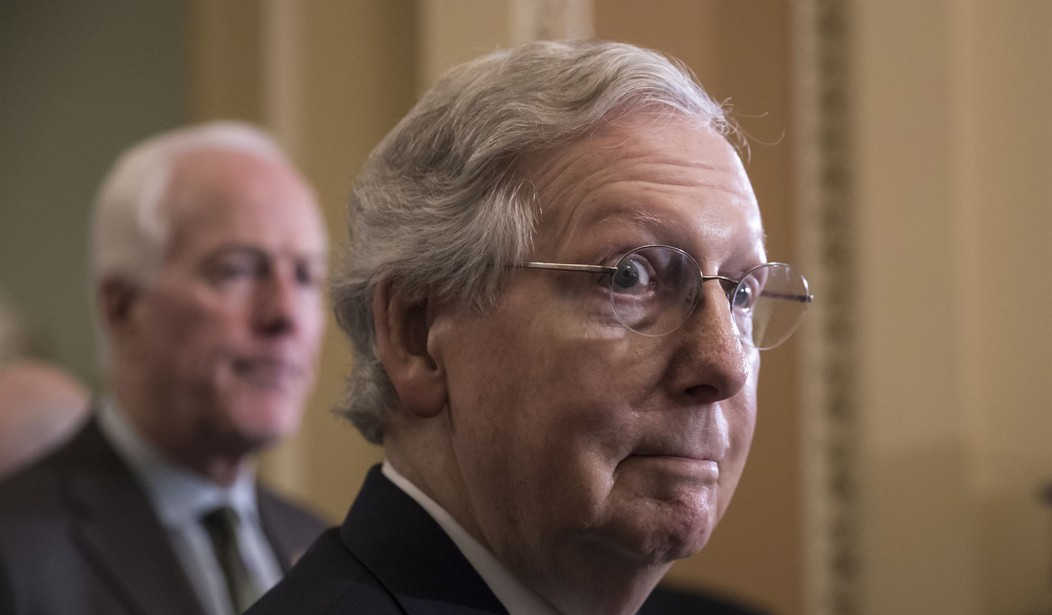Much has been argued about Mitch McConnell’s future as Senate Republican caucus leader, but much more has been written — in checks. McConnell has not just managed to outfight Chuck Schumer over the last fifteen months to halt Joe Biden’s progressive agenda, he’s also managed to outfight him for campaign cash. Politico marvels at Cocaine Mitch’s split of almost a quarter-billion in donations to the two leader-controlled super-PACs — and where McConnell plans to use his share:
A Mitch McConnell-aligned super PAC is booking $141 million in fall advertisements to help turn the Senate red, a staggering sum that sets the stage for a vicious battle over the chamber’s control.
The GOP-controlled Senate Leadership Fund is reserving eight-figure ad flights starting in September to protect Republican seats in North Carolina, Pennsylvania and Wisconsin as well as to take Democratic-held seats in Arizona, Georgia and Nevada, the group told POLITICO. SLF also laid down millions in Alaska to protect incumbent Lisa Murkowski from a Donald Trump-inspired primary challenge.
Those GOP plans follow the Chuck Schumer-aligned Senate Majority PAC’s moves to set aside $106 million in Arizona, Nevada, Wisconsin, Georgia and Pennsylvania, with most of those ads beginning in August.
Taken together, the two primary outside groups in Senate races have slotted nearly a quarter-billion dollars for the fall, with much more spending to follow those initial commitments.
In the coming weeks, just as over the past few months, we’ll continue to hear some nonsense about refusing to support McConnell in the next leadership election. That’s mainly been driven by Donald Trump supporters who resent McConnell’s refusal to back Trump’s election-challenge plays, and some candidates have been pushed into a position where they have to choose sides. In the end, no politician at this level will seriously challenge someone who controls this much cash for their re-election, not even self-funders.
This is precisely why Democrats stuck with Nancy Pelosi for almost two decades, too. That’s not to say it’s a great call in her case, or even in McConnell’s case. But if you really think that the Senate GOP caucus will mount a serious mutiny against a leader who can raise $141 million and outpace Schumer by $35 million, welcome to your first cycle in politics.
The more surprising part of this is where McConnell plans to target those funds, and how much:
The McConnell-connected Senate Leadership Fund will drop a whopping $37 million in Georgia this fall, $27 million in North Carolina, $24 million in Pennsylvania, $15 million each in Nevada and Wisconsin, $14 million in Arizona and $7.4 million in Alaska. The Schumer-connected Senate Majority PAC reserved $26 million in Pennsylvania, $22 million in Arizona, $21 million in Nevada, $12 million in Wisconsin and nearly $25 million in Georgia.
Both leaders offer offense and defense in these outlays, but the $7.4 million in Alaska is the most curious. McConnell appears to spend that cash to block a Trump push against Lisa Murkowski. That’s likely the safest play for McConnell to protect that seat and build a majority in the coming election, but the MAGA world is not going to like it. If this cycle is so good, why not finally pick off Murkowski and get a more reliably conservative vote in her place?
Because this cycle’s great environment has its own risks, former McConnell aide Steven Law told Politico:
“The only thing that ever concerns me when you’re in an environment that’s this good, and there’s so much talk about the red wave, is that complacency sets in,” Law said.
Not one of the Democratic-held Senate seats “is a layup” for the GOP, Law added. “And, you know, in several of these races … the Democratic incumbent is smart and well funded, and has a pathway to hold under their seat.”
Surveying the field, it’s tough to argue with that. Raphael Warnock in Georgia should be vulnerable, but he’s also got over $13 million in the bank. Mark Kelly in Arizona and Catherine Cortez Masto are also vulnerable, but Republicans haven’t performed terribly well in either state lately. The turnout models for the midterms in this cycle may overwhelm those and other Democratic incumbents, but we haven’t actually seen what that turnout will be like — at least not yet. Better to play it safe and keep the bird in the hand, rather than take the risks for a more exotic choice in the Alaskan wilderness.
Either way, these numbers make all of the chatter about McConnell’s future a purely academic exercise. As long as McConnell delivers this volume of campaign cash — and more to the point, controls it — he’ll remain atop the Senate GOP caucus.








Join the conversation as a VIP Member